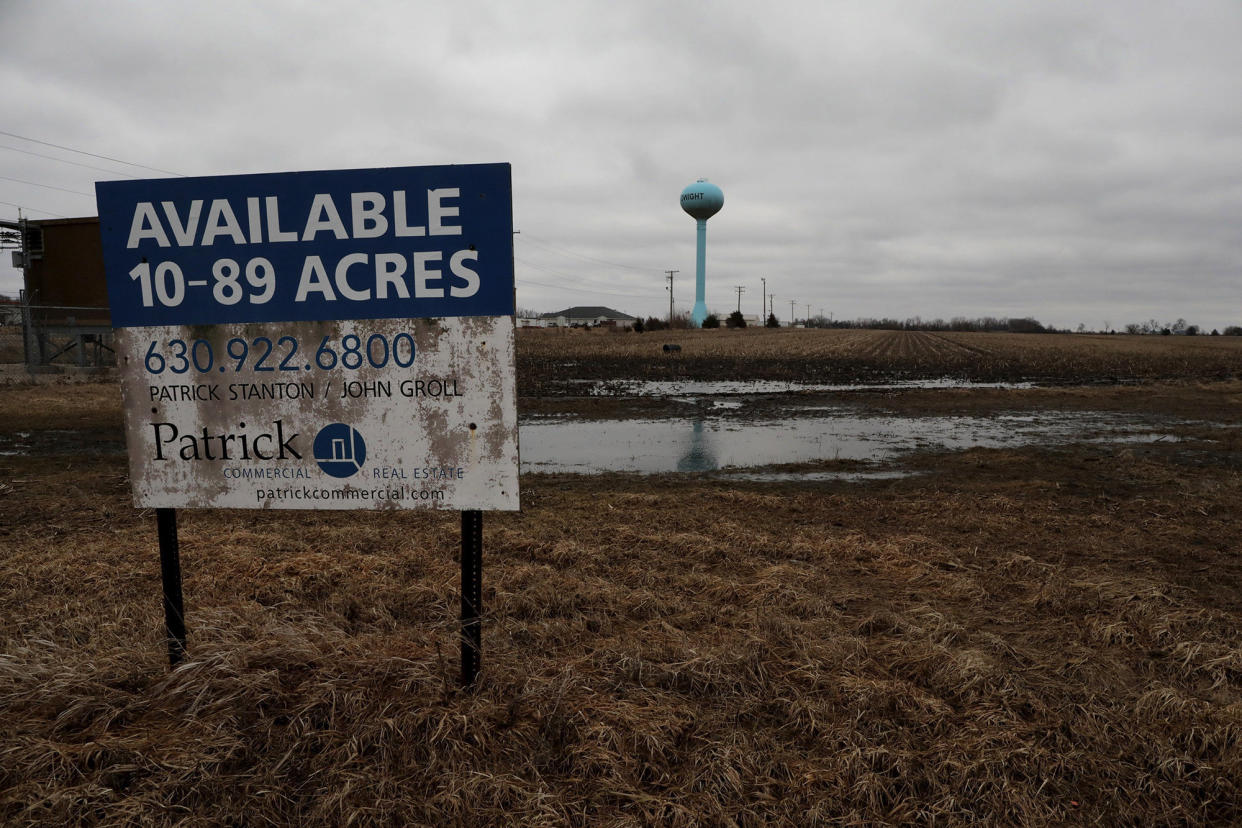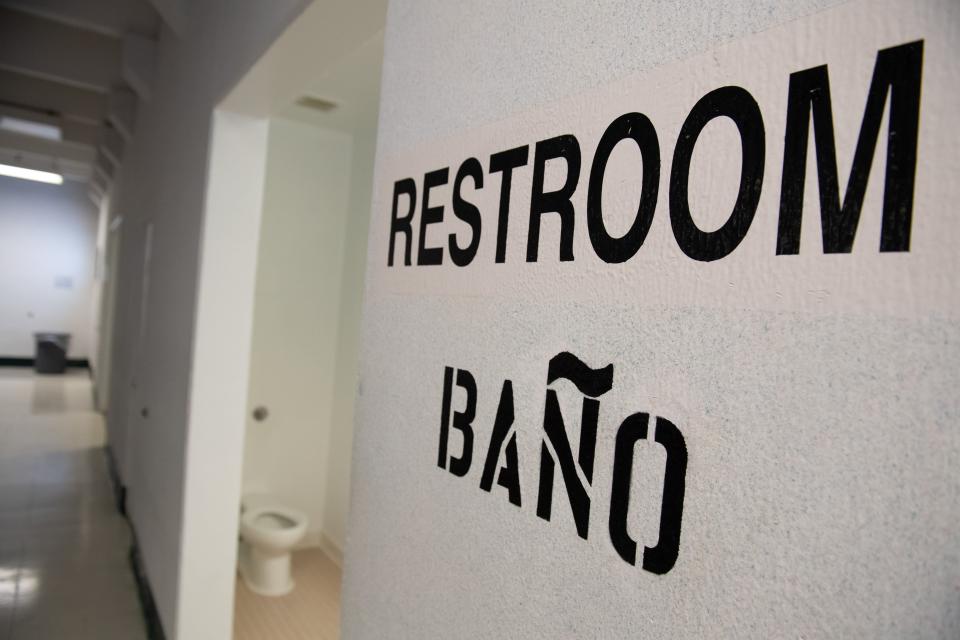Trump's controversial immigration policy stirs opposition to new detention centers

- Oops!Something went wrong.Please try again later.
The Trump administration’s plans to expand its long-term immigrant detention capacity to the interior of the country is meeting resistance from advocates, lawmakers and even some corporations in the Midwest, where the government hopes to locate the new facilities.
According to documents posted to a government website that lists federal business opportunities, the U.S. Immigration and Customs Enforcement agency, or ICE, is actively soliciting proposals from prospective contractors to open and operate detention facilities capable of housing approximately 1,000 immigrant detainees within an 80-mile radius of ICE’s Chicago field office, and another to house an estimated 500 detainees within a 100-mile radius of the agency’s field office in St. Paul, Minn. The window for responses recently closed regarding a similarly worded proposal request for a contract detention facility to house an estimated 600 males within 150 miles of the Detroit field office.
“ICE has identified a need for immigration detention services within the Chicago, Detroit and St. Paul Areas of Responsibility,” ICE spokesman Matthew Bourke told Yahoo News in an email. Those “areas of responsibility” or the jurisdiction covered by those three field offices alone stretches across 13 states, from Ohio to Kansas and up to North Dakota and Michigan.
Bourke went on to clarify that the need is “not necessarily specific to requirements in those areas,” but rather “Detention services in Chicago, St. Paul and Detroit would be part of the agency’s overall detention strategy.”
But the effort has posed a political, practical and ethical conundrum for a number of communities, including some conservative cities where Trump remains popular. Some of the pushback is just “not in my backyard” sentiment, but opposition also reflects the unpopularity of the administration’s immigration agenda and even the fear of driving away immigrants who are important to the local economy. A bill that would ban construction of privately run federal immigration detention facilities has passed one house of the Illinois state legislature.

ICE’s latest move toward securing new sources of detention space comes amid a continued influx of migrants at the southwest border, where Homeland Security officials have been looking for temporary alternative spaces — like the tent cities commissioned last week — to house and process the large numbers of asylum seekers, mostly families and unaccompanied children, who have filled existing facilities beyond their capacity.
Though undoubtedly exacerbated by the situation at the border, the move toward expanding capacity in the Midwest is not a reaction to the current crisis but part of a long-term plan to accommodate the increasing numbers of immigrants taken into custody by ICE’s aggressive enforcement activities in the interior.
In October 2017, the agency issued a request for information (or RFI) from prospective vendors to “to identify multiple possible detention sites to hold criminal aliens and other immigration violators” in the greater Chicago, Detroit, St. Paul and Salt Lake City areas. Those four field offices cover 17 states, from Nevada to Kentucky.
It was hardly the first time ICE had set its sights on the Midwest. Beginning in 2011, it sought to consolidate Chicago field office detainees in purpose-built, privately operated prisons, replacing a scattered patchwork of county jails in four states. The proposals were thwarted by local opponents and by immigration activists, who oppose moves to expand detention beds. “It just opens up the ability for ICE to hold many more individuals,” said Hena Mansori, managing attorney of the National Immigrant Justice Center’s Adult Detention Project.

According to data provided to Yahoo News by ICE, as of April 6, the average daily number for fiscal year 2019 of ICE detainees being held within the Chicago area of operations was 1,319 — a population that Mansori described as “a mixture of people who are apprehended locally, who have roots and get picked up despite having families here ... along with folks transferred up from the border and housed here because [there is] space.” Both groups, she predicted, would likely increase with the opening of a 1,000-bed detention center like the one ICE is seeking to build in the Chicago area.
Responses received by ICE to the RFI, which the National Immigrant Justice Center obtained last year via a Freedom of Information Act request, show a number of companies expressed interest in this opportunity — from the country’s two largest private prison operators, GeoGroup and CoreCivic, to some lesser-known companies such as the Richmond, Va.-based Immigration Centers of America, which operates a 690-bed ICE detention center in Farmville, Va.
Requests for Information “do not necessarily precede contracts,” an ICE official noted, but are simply “part of a general acquisition strategy to determine if services can be viably provided in a specific area.” But to the private-prison companies, it was a potential windfall, and they began scouting construction sites and working to secure the support of community leaders, who were forced to weigh the potential economic benefits against ethical and political considerations.
In Ionia, Mich., a city of nearly 11,200 about 130 miles from the Detroit field office, Immigration Centers of America presented city officials with a plan to demolish a former state prison and construct a brand-new, privately run immigrant detention center in its place. The 600-bed facility, they estimated, would create 363 jobs and generate an annual $34.5 million in economic impact for the region, which had suffered following the prison’s closure in 2009. Still, the proposal left many city officials feeling conflicted, weighing jobs against their ethical concerns about large-scale detention of immigrants, in light of the Trump administration’s controversial policies, such as family separation.
Though it would ultimately be up to the Ionia City Council to decide whether to allow the detention center to open, as the sole bidder for the shuttered state correctional facility, ICA was permitted by state officials under Republican then-Gov. Rick Snyder to move forward with the project last fall. But Snyder was nearing the end of his second and final term in office at the time, and in February of this year, newly elected Democratic Gov. Gretchen Whitmer announced her decision to block the sale of the former prison to ICA, citing, among other concerns, the fact that ICA could not guarantee the facility would not be used to house adults who had been separated from their children.
Other companies have encountered similar kinds of pushback against their proposals, even in places like Elkhart County, Ind., where nearly two-thirds of voters backed Trump’s 2016 campaign.

Two hours east of Chicago, Elkhart County is a hotbed of Trump supporters — thousands of whom gathered to hear the president speak at a rally there last May — and it’s also a center of the RV industry, whose increased reliance on immigrant labor in recent years has resulted a growing Latino population. This dynamic played a major role in how the county reacted earlier this year to a proposal by CoreCivic, one of the country’s largest private prison companies and a leading ICE detention contractor, to build a 1,200-bed immigrant detention center in Goshen, the county seat, where 30 percent of the population is Hispanic.
Here too elected officials as well as business leaders had to weigh the potential new jobs and tax revenue CoreCivic promised against the potential harm an ICE detention center could cause.
“If the facility gets built, it would be harder to attract new workers and residents, which we very much need to fill the estimated 9,000+ open jobs in Elkhart County,” Goshen Mayor Jeremy Stutsman wrote in an open letter published online in late January. Stutsman concluded that “any tax dollars generated by the project wouldn’t be enough to offset the long-lasting damage such a facility would do to our county — both in terms of perception and in terms of creating an unwanted unwelcoming reputation.”
Shortly after, CoreCivic officials informed Elkhart County commissioners that the company was withdrawing its proposal for the 250,000-square-foot detention center.
“There continues to be a lot of really solid organizing against these sorts of plans even in locations that, on paper, you wouldn’t think there would be much of a groundswell of local support” for immigrants, said Julian Lazalde, civic engagement and policy analyst at the National Immigrant Justice Center. Just this week, Lazalde noted, ICA withdrew yet another proposal for the construction of a 500-bed facility in the small eastern Wisconsin city of New Richmond, just over 40 miles west of ICE’s St. Paul field office in Minnesota.
Local advocacy groups had been organizing for several weeks in an effort to urge state and local officials to reject the plan for the new detention center.
“The more people find out about these proposals, the less they like it,” said Fred Tsao, senior policy counsel at the Illinois Coalition for Immigrant and Refugee Rights, which, along with the NIJC, has worked with local advocates on the ground in many of the fights against ICE’s detention expansion efforts in the Chicago area.
Though most opposition efforts have succeeded so far, last month, in the face of vocal opposition from local organizers and community members, the Village Board in Dwight, Ill., approved a plan by ICA to build a 1,200-bed immigrant detention facility in this small town 77 miles southeast of Chicago.

Dwight’s approval of ICA’s proposed detention center prompted Democratic lawmakers in Illinois to take legislative action — putting forth a bill that would expand the state’s long-standing ban on the use of private prisons to include civil detention facilities, like those used to house immigrants in deportation proceedings. Earlier this month, the bill, introduced by Democratic Rep. Kelly Cassidy of Chicago, passed the state House.
Though the bill’s future in the state Senate is uncertain, Tsao expressed confidence that lawmakers will be successful in “closing the door once and for all” to for-profit immigration detention in Illinois. Asked about the possibility that, if the legislation does become law, ICE will simply build in another state within the Chicago field office region, Tsao noted that other localities, such as Elkhart, are also opposed.
“I’m hoping that all of these victories on our side are an indication to ICE and DHS and this administration that detention is not the way to go,” he said.
Recent actions, however, suggest the administration remains committed to finding more places to house more immigrants.
Two days after the board approved the plan in Dwight, ICE posted an official Request for Proposals soliciting “comprehensive detention services for estimated 1,000 detainee population preferably within 80 mile radius of Chicago field office.” A similar solicitation for a 500-detainee facility within 100 miles of the St. Paul field office was also posted that same day.
ICE has yet to award any contracts in relation to these solicitations, and even then, such contracts are not scheduled to take effect until June 2020. Congressional appropriations for fiscal year 2020 are still pending, but ICE has already requested additional funding for next year’s budget to increase its nationwide detention capacity to 54,000.
However, the latest detention numbers are already beginning to climb beyond the 45,274 beds Congress agreed to for FY2019. As of April 15, the average daily population of ICE detainees for the current fiscal year was 46,636. On April 18 alone, a total of 50,223 individuals were in ICE custody, including 49,548 in adult detention facilities and 675 held in family residential centers, as part of family units.
Earlier this month, ICE issued two additional requests for detention-related information, one for potential detention services in the greater Houston area, the other seeking to identify one or more possible detention facility sites capable of housing 600 to 800 adult male and adult female “criminal aliens, detainees, and other immigration violators” within 50 miles of the Baltimore field office.
Read more from Yahoo News:
Trump was ‘fighting for his political life,’ his former lawyer says
'It's already begun': Feedback loops will make climate change even worse, scientists say
Revealed: The U.S. military's 36 code-named operations in Africa
Video shows extensive fire damage inside Notre Dame Cathedral
Concerns mount over Jared Kushner's role in GOP money machine



